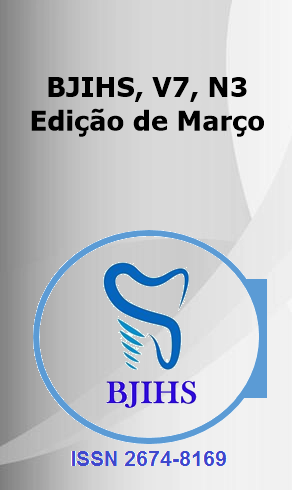Abstract
The traditional teaching method, with the use of expository theoretical classes and identification of anatomical structures has contributed to create a feeling among students of unnecessary memorization. Thus, the main objective of this study is to report students' experiences regarding the use of clinical cases as an active methodology in teaching and learning the discipline of human anatomy as a differential. This is a descriptive study, of the experience report type, about the use of clinical cases as a teaching tool in human anatomy, based on active learning methodologies. The present study analyzed the academic semester of 2022.2, from August to November 2022. The developed method consists of four stages. The first takes place in the classroom, where there is a dialogued exposition of the theoretical subject. The second consists of the presentation of the clinical case predetermined in the discipline's teaching plan, the third in the practical class with synthetic and cadaveric pieces, with the aid of anatomical scripts with the names of the anatomical structures to be identified and the fourth stage is the Laboratory of Skills and Simulations, in which the structures will be palpated and tested on the own body of the students who form pairs. Thus, the clinical case, mainly because it is a medical course, becomes a major highlight in the assimilation of theory to practice. This method was positive for learning because it aimed at quality training related to daily medical practice, with the aim of making concrete what was learned. In this way, the importance of using active methodologies within the subject of human anatomy for the development of skills beyond the scientific is perceptible. In this sense, the use of these new methods by teachers becomes essential for the development of a more proactive, responsible and critical future professional.
References
ALMEIDA, Nelson et al. Avaliação da importância e do aprendizado promovido em atividades de Extensão Universitária. Revista UFG, v. 15, n. 17, 2015.
ARRUDA, Felipe; DANEK, Allan; ABRÃO, Karen; QUILICI, Ana. Elaboração de vídeos médicos educacionais para treinamento de habilidades de estudantes do curso de medicina. Revista Brasileira de Educação Médica, v. 36, n.3, 2012.
BACICH, Lilian; MORAN, José. Metodologias ativas para uma educação inovadora: uma abordagem téorico-prática. Porto Alegre: Penso, 2018.
FARIAS, Pablo; MARTIN, Ana; CRISTO, Cinthia. Aprendizagem Ativa na Educação em Saúde: Percurso Histórico e Aplicações. Revista Brasileira de Educação Médica, v. 30, n.1, 2015.
FILATRO, Andrea; CAVALCANTI, Carolina Costa. Metodologias Inovativas na educação presencial, a distância e corporativa. 1ª ed. São Paulo: Saraiva Educação, 2018.
FOUREAUX, Giselle et al. O ensino-aprendizagem da anatomia humana: avaliação do desempenho dos discentes após a utilização de mapas conceituais como uma estratégia pedagógica. Ciência & Educação (Bauru), v. 24, n. 1, p. 95-110, 2018.
FREIRE, Paulo. Pedagogia da autonomia: saberes necessários à prática educativa. São Paulo: Paz e Terra, 1996. Coleção leitura, p. 21, 2011.
KALA, Sasikarn; ISARAMALAI, Sang; POHTHONG, Amnart. Electronic learning and constructivism: a model for nursing education. Nurse Educ Today, v.30, n.1, 2010.
MARQUES, Fernanda; XAVIER, Marcelo. Percepções discentes sobre as abordagens tradicional e baseada em problema na anatomia patológica. Revista Brasileira de Educação Médica, v.46, n.2, 2022.
MASETTO, Marcos. Metodologias ativas no ensino superior: para além da sua aplicação, quando fazem a diferença na formação de profissionais. Revista e-Curriculum, v.16, n. 3, 2018.
PEZZI, Lucia; CORREIA, João; PRINZ, Rafael; NETO, Silvio. Anatomia clínica baseada em problemas. 2° ed. Rio de Janeiro: Guanabara Kooban 2017.
ROMAN, Cassiela et al. Metodologias ativas de ensino-aprendizagem no processo de ensino em saúde no Brasil: uma revisão narrativa. Clin Biomed Res, v. 37, n.4, p. 349-357, 2017.

This work is licensed under a Creative Commons Attribution 4.0 International License.
Copyright (c) 2025 Amanda Maria e Silva coelho, Rebeca Nunes Bandeira, Marina Muniz Macedo, Fabíola Santos Oliveira Pacheco, Cleonice Lacerda de Araújo, Naiane Lucas de Andrade, Míriam Gonçalves de Castro, Carla Christine Munaretto, Thomaz Heringer machado Silveira, Jessica Camila do Nascimento Barboza, Thaís Pedra Oliveira

